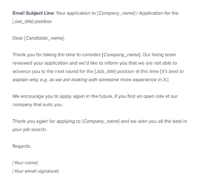Job application rejection email template
Use this job application rejection email template to inform candidates who’ve applied for one of your open roles that they will not advance to the next stage of your hiring process.
 Avoid leaving job applicants guessing. When you screen candidates, make sure to inform those who don’t qualify that they will not move forward and thank them for their application. Communicate promptly during all your hiring stages to build a more positive candidate experience.
Avoid leaving job applicants guessing. When you screen candidates, make sure to inform those who don’t qualify that they will not move forward and thank them for their application. Communicate promptly during all your hiring stages to build a more positive candidate experience.
If you’re rejecting applicants you haven’t interviewed, it’s best to keep your email simple and brief. Thank them for considering your company and prompt them to apply again in the future, if you think they might qualify for another job opening. Keep your tone professional yet polite, so that you turn down candidates without burning bridges.
Job application rejection email template
Email Subject Line
Your application to [Company_name] / Application for the [Job_title] position
Email body
Dear [Candidate_name],
Thank you for taking the time to consider [Company_name]. Our hiring team reviewed your application and we’d like to inform you that we are not able to advance you to the next round for the [Job_title] position at this time [it’s best to explain why, e.g. as we are looking with someone more experience in X.]
We encourage you to apply again in the future, if you find an open role at our company that suits you.
Thank you again for applying to [Company_name] and we wish you all the best in your job search.
Email sign off
Regards,
[Your name]
[Your email signature]
What should be included in a job application rejection email?
A job application rejection email serves as a pivotal aspect of a company’s recruitment strategy, ensuring candidates, irrespective of the outcome, are handled with dignity and professionalism. It’s essential to initiate the correspondence by personally addressing the applicant by their name, illustrating that the message isn’t a mere generic auto-response. Expressing gratitude for their interest and the time they’ve invested in the application process is paramount.
Following this appreciation, the email should straightforwardly convey the decision, sidestepping intricate or euphemistic terms. While being transparent is fundamental, the delivery of the rejection should be done with tact and sensitivity.
Some organizations opt to provide concise feedback or the reason for rejection, particularly for those candidates who advanced to the latter stages of the interview process. If chosen to be included, this feedback should be both constructive and tenderly framed, aiming to assist rather than dishearten the applicant.
Regardless of the current outcome, it’s beneficial to mention the possibility of future opportunities. This approach not only provides a semblance of hope but also preserves a potentially fruitful relationship between the candidate and the company.
More resources: